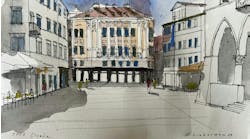Architecture firms have long been known to dabble in product design—look no further than the coffee tables of Gio Ponti or the dining room chairs of Frank Lloyd Wright. While most firms produce bespoke creations for a single project, few have the resources to bring these pieces to the mass market. But HOK Product Design, an independent arm of HOK, has been successfully navigating these waters since 2009. Helmed by Director Susan Grossinger, the interior design veteran and her team collaborate with manufacturers to infuse their portfolio with an architectural aesthetic.
interiors+sources: HOK’s creations span from carpet and furniture to lighting and ceramic tiles; how do you decide which product categories you want to develop?
Susan Grossinger: For starters, we aren’t bound by a single product category. In most cases, our inspiration comes from our own employees. We have 1,800
people across 23 offices—HOK designersoften discover a good product idea because they were looking for an item to specify and couldn’t find it in the market.
i+s: You have introduced more than 40 products in eight years. What are some of your favorites?
sg: That’s like asking me to choose my favorite child! I personally love lighting. Not only is it beautiful, but a difference in lighting can radically change how people experience a space. For example, we worked with Focal Point to create the Facetta luminaire. By incorporating an angled diffuser, the fixture adds a new element to ceiling grids.
Allsteel’s Gather also stands out as a great example of a client collaboration. This partnership resulted in a unique, never-before-seen set of products in the industry and helped position Allsteel in a market they hadn’t thrived in before.
i+s: What is it like to return to the Gather collection and expand it with new offerings?
sg: It’s like going home to visit with family you haven’t seen in a while. The original launch of Gather was focused on encouraging collaboration in the workplace. With last year’s Gather Again, the Reflect and Clubhouse pieces provided heads-down space. Each phase of the collection continues to address a different need. The next iteration is a café concept that will launch at NeoCon 2018. These spaces aren’t for a quick cup of coffee anymore; they have evolved into a spot for meetings, touchdowns, scrum, and getaways.
i+s: What inspires you to take a functional, everyday piece and give it a design upgrade?
sg: With Victor2, the recycling station by Steelcase, we wanted to change behavior. These types of products usually have an industrial look and don’t fit into a space well, which means they may be ignored. We wanted to create an elegant product that would inspire people to recycle. It has an upscale look but is also functional with smartly categorized bins and dishwasher-safe parts.
We are also working with Kewaunee Scientific on a next-generation lab design that speaks to the high-tech nature of research. Lab systems as a product category have been fairly static; researchers are doing some incredible work in these settings yet the furniture is nearly old fashioned.
i+s: What are the challenges of bringing these creations from the drawing board to reality?
sg: This is truly a collaborative process. Manufacturing clients have a better understanding of production so there’s a lot of back-and-forth on the design. There are many factors we have to balance: costs, aesthetics, and manufacturability. Because it takes a long time to get a product to market, the launched version often shifts significantly from the original design. A newly released code or a competitor beating us to the punch can also alter the development.
That’s why it’s less about the products and more about the client collaboration. The relationship has to be great so everyone is driving toward the same goal. The people at these companies have turned the growing pains of launching a startup into a life-changing experience. Seeing those products coming to market has been the highlight of my career.
i+s: What are some trend evolutions you’ve observed since you joined HOK in 1994?
sg: The work environment is completely different. I lived in “Dilbertland” when I first started and that was acceptable. But today’s constantly evolving businesses have made cutting down silos so important. The change in the speed of work has also been unimaginable. I didn’t have email in 1994 so mail packages and faxes were treated as a priority; now they are at the bottom of the pile.
Sustainability has also come to the forefront. Just a handful of people in the ‘90s were applying sustainability principles to the work environment. Now LEED, WELL Building Standard, and biomimicry have become a central tenant to the way we design.
i+s: What does HOK Product Design have coming down the pipe?
sg: Many of our upcoming products speak to the changing nature of spaces at work, particularly how collaboration occurs in conference rooms, cafés, and town halls. We have a lounge chair with Techno coming out and a corporate/higher education crossover from Koleksiyon that will debut [this year] at NeoCon. Beyond corporate offerings, we are developing architectural curtainwalls and producing a kitchen concept with Scavolini for microliving.
Photography courtesy of HOK Product Design


